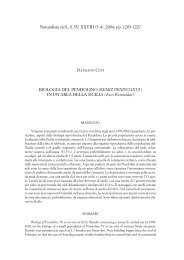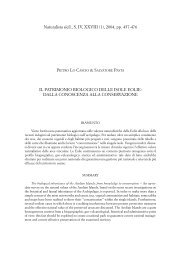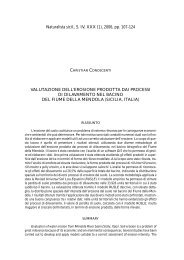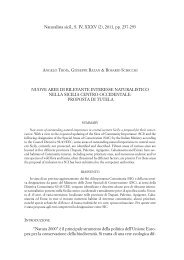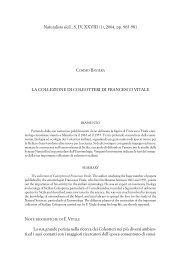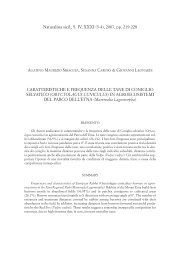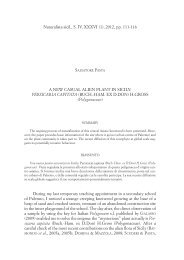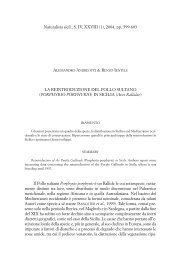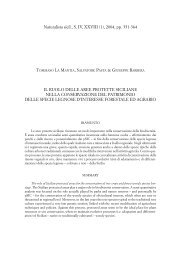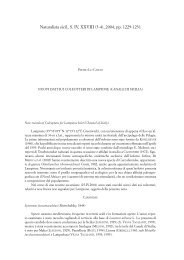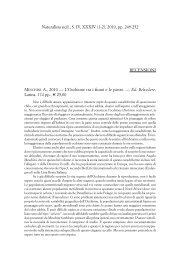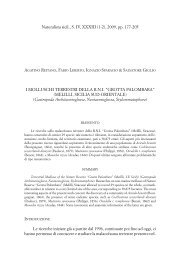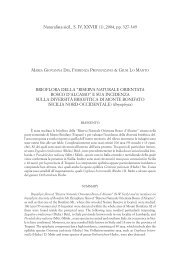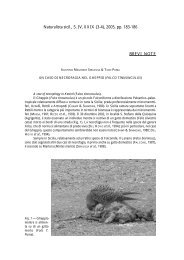2007,pp - Società Siciliana di Scienze Naturali
2007,pp - Società Siciliana di Scienze Naturali
2007,pp - Società Siciliana di Scienze Naturali
Create successful ePaper yourself
Turn your PDF publications into a flip-book with our unique Google optimized e-Paper software.
270 M. SKUHRAVÁ, V. SKUHRAVY´ & B. MASSA<br />
mainly in the “Giar<strong>di</strong>no Inglese” of Palermo; he described the species as<br />
Cecidomyia Borzì naming it in honour of Prof. A. Borzì, <strong>di</strong>rector of the Botanical<br />
Garden. Afterwards DE STEFANI (1898c, 1906c) highlighted that it was<br />
very abundant in the Botanical Garden of Palermo. DE STEFANI jr (1942) also<br />
reported it at Villa Crispi, Palermo (in 1920’ Giar<strong>di</strong>no Inglese was named<br />
“Villa Crispi” in honour of the Sicilian character Francesco Crispi). Reference:<br />
TROTTER & CECCONI (1900-1917: N. 134), Palermo, 1900, leg. De Stefani.<br />
Distribution: Me<strong>di</strong>terranean.<br />
Asphondylia calycotomae Kieffer, 1912<br />
A solitary larva develops in swollen leaf bud (hibernating generation)<br />
and in deformed pod (summer generation) of Calycotome spinosa L.<br />
(Fabaceae) (Pl. VIII, Figs. 44 and 45). Original material for description came<br />
from Algeria. DE STEFANI (1919) recorded this species from Sicily (Monti <strong>di</strong><br />
Renda, Monreale) (600 m); DE STEFANI jr (1942) reported it also from Ficuzza<br />
(700 m) in late May. Distribution: Me<strong>di</strong>terranean.<br />
Asphondylia ca<strong>pp</strong>aris Rübsaamen, 1893<br />
Larvae develop in swollen flower buds of Ca<strong>pp</strong>aris spinosa L. (Ca<strong>pp</strong>aridaceae)<br />
(Pl. IV, Figs. 19 and 20). RÜBSAAMEN (1893) described this species<br />
based on material obtained from Prof. Baccarini, collected in “Catania, Sicily,<br />
October 1893”, as it is written on the label of specimens of the type series<br />
deposited in the Museum für Naturkunde, Humboldt Universität, Berlin,<br />
Germany. Afterwards, DE STEFANI (1905a) reared some parasitoids from its<br />
galls. DARVAS et al. (2000) evaluate this species as a minor pest of caper. Reference:<br />
DE STEFANI (1906c), DE STEFANI jr (1942), who reported it from Mt. Pellegrino<br />
(Palermo). Recent records: Linosa Is. 28.7.<strong>2007</strong>, leg. B. Massa; Maccalube<br />
<strong>di</strong> Aragona Nature Reserve 9.8.<strong>2007</strong>, leg. B.Massa (from galls many<br />
adults and some parasitoids emerged in the following days). Distribution:<br />
Me<strong>di</strong>terranean.<br />
Note. PERI et al. (2006) reported that the key pest on crops of caper<br />
(Ca<strong>pp</strong>aris spinosa) in the Sicilian island is Asphondylia genna<strong>di</strong>i. As the identification<br />
of species belonging to the genus Asphondylia is very <strong>di</strong>fficult, we<br />
prefer to consider A. ca<strong>pp</strong>aris as a native Sicilian species and the gall inducer<br />
on inflorescences of C. spinosa, as already reported by GENDUSO (1990) from<br />
Pantelleria. This problem needs further taxonomic research.<br />
Asphondylia conglomerata De Stefani, 1900<br />
Larvae cause large galls, up to several centimeters long, on stems of<br />
Atriplex halimus L. (Chenopo<strong>di</strong>aceae). Such large gall usually includes the



